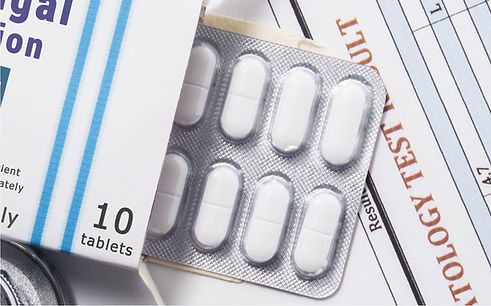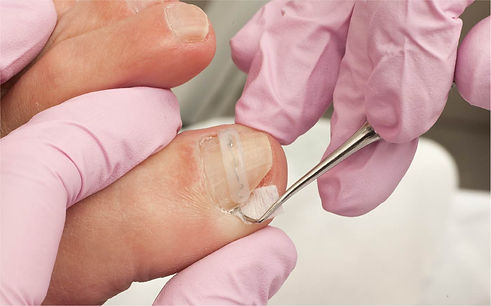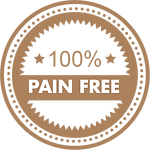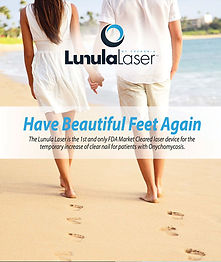
Lunula Laser Fungal Nail Treatment
What Are Fungal Nail Infections?
Nail fungus is a common condition that begins as a white or yellow spot under the tip of your fingernail or toenail. As the fungal infection goes deeper, nail fungus may cause your nail to discolour, thicken and crumble at the edge. It can affect several nails.

Fungal infection on the outside of the toenail in cases of onychomycosis

Superficial white onychomycosis
-
What are the causes of fungal nail?Fungal nail infections are caused by various fungal organisms (fungi). The most common cause is a type of fungus called dermatophyte. Yeast and molds also can cause nail infections. It can develop in people at any age, but it's more common in older adults. As the nail ages, it can become brittle and dry. The resulting cracks in the nails allow fungi to enter. Other factors — such as reduced blood circulation to the feet and a weakened immune system — also may play a role. Toenail fungal infection can also start from athlete's foot (foot fungus), and it can spread from one nail to another. But it is uncommon to get an infection from someone else. Reference from MayoClinic
-
Ingrown Toenail Treatment (Onychocryptosis)An ingrown toenail is the most common reason why people visit a podiatrist. This condition usually affects the big toenail but can affect the lesser nails too. A piece of nail or a serrated edge pierces and penetrates the soft skin at the edge of the nail, or a spike of nail penetrates the fleshy end of the toe (distal pulp). This results in soreness or extreme pain, swelling and redness and often produces pus. The condition affects both men and women equally, regardless of age. Is it caused by either an injury due to physical activity, ill-fitting shoes or poor nail cutting.
-
What are the symptoms of fungal nail? ▼You may have nail fungus if one or more of your nails are: Thickened Whitish to yellow-brown discoloration Brittle, crumbly or ragged Distorted in shape A dark color, caused by debris building up under your nail Smelling slightly foul
-
Lower Limb Pain & Structural Problems ▼For problems such as foot pain, lower limb pain, hallux valgus, flat feet, high arched feet, plantar fasciitis, etc., the therapist will first diagnose the severity of the problem, the patient's living habits, sensitivity to pain, etc., and then provide appropriate treatment.
-
Orthotics / Insoles / Footwear ▼Custom foot orthotics are specialized shoe inserts that can help treating your foot and leg problems. Many ‘biomechanical’ (walking) complaints such as heel pain, knee pain and lower back pain are caused by poor foot function. Orthotics re-aligns the foot and ankle bones to their neutral position, thereby restoring natural foot function. In turn this helps alleviate problems in other parts of the body. In addition, orthotics gives a more even weight distribution, taking pressure of sore spots (e.g., the ball of the foot, corns in between toes, bunions) and they provide some shock absorption.
-
Gait & Biomechanical Assessment ▼Our body parts are interconnected, and pain in one area can often originate elsewhere. By examining the entire body, Biomechanical Assessments can help diagnose and resolve associative pain and injuries. A static and dynamic biomechanics assessment is an investigation into your lower limb function – looking closely for abnormalities and compensations. The assessment will focus on the structure, posture, range of motion, plantar pressure, alignment, strengths and weaknesses of the foot and will include the pelvis, legs and knees and how they work together as pain in one area can indicate a weakness or structural problem in another. The information gained from a biomechanical assessment forms the basis for a rehabilitation programme, or if the problem is mechanical, an orthotic will be prescribed.
-
General Podiatry Care ▼We diagnose and treat all foot disorders and deformities, as well as providing general foot treatment and advice. We treat all problems on feet of all ages as well as all problems associated with a wide range of medical conditions. Perhaps you have a painful lesion or hard skin on your foot or maybe you have thickened nails that you cannot manage, general podiatry care will help give pain relief and allow you to walk pain free.
-
Children’s Foot Assessments ▼As children and toddlers grow and develop, they can suffer from a range of foot problems. We believe by assessing children’s feet early in their lives that any issues can be picked up and addressed before becoming more problematic. Prevention is always better than cure! Common foot problems that your child may suffer from are: Club foot Heel pain (Sever’s Disease) Ingrown toenails Knee pain (Osgood Schlatter’s disease) Metatarsus Adductus Sprained ankle Tarsal coalitions Tinea athletes foot Warts (verrucae)
-
Diabetic Foot Care ▼Diabetes can reduce the blood supply and damage the nerves in your feet, leading to a number of serious foot problems which is why it is recommended to have a diabetes foot assessment performed by a podiatrist and ongoing podiatry care if necessary. Poor glucose control generally causes two main complications in the feet: Nerve damage that results in peripheral neuropathy Poor blood supply & circulation If nerve damage occurs, you may experience some of the following symptoms in your feet: Numbness or altered sensation Pins & needles in the feet Burning pain in the legs and feet, usually more noticeable at night Coldness in the legs and feet Long Term Lower Limb Complications of Diabetes: Loss of protective sensation Decreased blood supply to the feet Increased risk of infection Diabetic foot ulcers, amputations and gangrene A diabetes foot assessment performed by a podiatrist every 3 to 12 months is advisable, depending on your risk category, the podiatrist will use the following validated assessment tools to establish a foot risk status: Neurological Assessment Vascular Assessment Footwear assessment Dermatological Assessment Screen for skin cancers General foot and Nail care Diabetic foot health education and information Once a foot risk status is determined, the podiatrist may makerecommendations based on the results. This may include recommendations for footwear modifications and orthotics to reduce high plantar pressure sites that are at risk of ulceration. Recommendations are made to help you achieve your goal and follow up appointments are scheduled based on your specific needs and desired outcomes.
-
How effective is the treatment?Clinical studies have shown that the Lunula laser treatment process has the highest success rate of all available treatments, with a success rate of approximately 85%.
-
What are the possible side effects?No significant side effects have been reported.
-
What Patients Should expect During Laser Treatment?There have been no reported adverse reactions to the laser treatment. It is well-tolerated, quick, safe, and painless Sit comfortably on the examination chair Place the foot in the Lunula Laser The laser targets the treatment area on the foot for 12 minutes After the treatment there is no downtime nor additional medicine The procedure is quick and painless, and each foot takes about 12 minutes to treat. Most patients have multiple sessions to see optimal results, and sessions are usually spaced out about seven days apart.
-
Does it hurt?Treatment with Lunula ‘Cold laser’ is completely pain-free.
-
How does the Lunula laser work?This FDA-approved toenail fungus treatment is revolutionary. With low-level laser energy, the Lunula Laser uses photochemistry to target the toenail fungus and stimulate blood flow. Photochemistry is the science of light and colour With red and violet laser lights, the photochemical reaction caused by the laser kills the fungus and stimulates new, clear toenail growth. While the laser aggressively treats the fungus, it does not affect the rest of the toe or foot.
Treatments for Fungal Nails
A typical Fungal Nail Consultation would involve the Podiatrist assessing and diagnosing the infected nails. In some cases, clippings or scrapings are taken and sent off site to be tested. The Podiatrist would then prep the nails, by cutting them back and grinding them down to remove some of the thickness.
We would then run through the best treatment options for you, whether that be topical, oral or laser therapy, you’ll also be coached on how best to self-manage your issue so that it does not reoccur.
Fungal nail infections can be difficult to treat. Treatment depends on the severity of your condition and the type of fungus causing it.

Topical Anti-fungal Solutions
Topical treatment is usually the first line therapy for fungal nails. The condition of the nail can reflect the effectiveness of the treatment, so it is recommended you visit a Podiatrist before starting treatment. It is advised for all topical treatments, to gain the best results, that the nail is thinned as much as possible and, nail that may have lifted or become brittle, is cut away and exposes the nail bed. Without this, it may delay or lower the effectiveness of treatment. This allows the solution to penetrate the nail bed more effectively.
Oral Medications
Oral anti-fungal medication is still considered the gold standard in nail fungus treatment and it is reported to have a 70% success rate. A course on oral anti-fungal medication can last up to 12 weeks. The reason why its success is greater is because the medication is circulated in your blood stream and this treats the nail fungus 24 hrs around the clock.
The main draw back with oral anti-fungal medication is that it is very strong medication and can often have nasty side effects, including liver damage. For this reason oral anti-fungal drugs are usually only prescribed following confirmation of diagnosis through pathology and treatment should be carefully monitored. Oral anti-fungal medication is best used for severe or chronic nail fungus infections or those which haven’t responded to conservative treatment.


Nail Surgery / Nail Avulsion
In cases where a nail infection has progressed to the “severe” stage and is extremely painful, your doctor may recommend removing your nail. A new nail will usually grow in its place, but it will come in slowly and may take as long as a year to grow back completely. Sometimes surgery is used in combination with a topical solution that treats the nail bed to further inhibit the fungus.
Lunula Laser® for Fungal Nails
What is Lunula Laser®?
The Erchonia Lunula laser device is a Low-Level Laser Light that is specifically designed for treating onychomycosis – toenail fungus. Lunula Laser poses none of the risks and harmful side effects of oral anti-fungal medications and is painless, unlike other laser therapies.

100% Pain Free
-
The first and only non-thermal (Cold Laser) FDA Market Cleared laser device for the temporary increase of clear nail for patients with Onychomycosis
-
The patient will feel NO heat or pain from the laser

Risk Free
-
Made in USA
-
No heat used and therefore there are ZERO risks involved with it is usage
-
The machine is computer automated to ensure consistency of coverage of the nail (Comparatively, hot lasers are generally handheld and run the risk of inconsistent application)

Effective outcomes supported by research, clinical trials and anecdotal evidence
-
Receive FDA-clearance based on a double-blind, randomized, multi-site and placebo-controlled clinical trial
-
Clinical trial proved 89% of the Lunula Laser patients respond to treatment
-
Have a higher success rate and better patient outcomes than other conventional treatments, such as hot laser therapy which other clinics use
-
No recovery period after - you can wear socks and shoes immediately after treatment

No significant side effects
-
No chance for liver toxicity
-
Do not interfere or interact with any systemic medicine
-
What are the causes of fungal nail?Fungal nail infections are caused by various fungal organisms (fungi). The most common cause is a type of fungus called dermatophyte. Yeast and molds also can cause nail infections. It can develop in people at any age, but it's more common in older adults. As the nail ages, it can become brittle and dry. The resulting cracks in the nails allow fungi to enter. Other factors — such as reduced blood circulation to the feet and a weakened immune system — also may play a role. Toenail fungal infection can also start from athlete's foot (foot fungus), and it can spread from one nail to another. But it is uncommon to get an infection from someone else. Reference from MayoClinic
-
Ingrown Toenail Treatment (Onychocryptosis)An ingrown toenail is the most common reason why people visit a podiatrist. This condition usually affects the big toenail but can affect the lesser nails too. A piece of nail or a serrated edge pierces and penetrates the soft skin at the edge of the nail, or a spike of nail penetrates the fleshy end of the toe (distal pulp). This results in soreness or extreme pain, swelling and redness and often produces pus. The condition affects both men and women equally, regardless of age. Is it caused by either an injury due to physical activity, ill-fitting shoes or poor nail cutting.
-
What are the symptoms of fungal nail? ▼You may have nail fungus if one or more of your nails are: Thickened Whitish to yellow-brown discoloration Brittle, crumbly or ragged Distorted in shape A dark color, caused by debris building up under your nail Smelling slightly foul
-
Lower Limb Pain & Structural Problems ▼For problems such as foot pain, lower limb pain, hallux valgus, flat feet, high arched feet, plantar fasciitis, etc., the therapist will first diagnose the severity of the problem, the patient's living habits, sensitivity to pain, etc., and then provide appropriate treatment.
-
Orthotics / Insoles / Footwear ▼Custom foot orthotics are specialized shoe inserts that can help treating your foot and leg problems. Many ‘biomechanical’ (walking) complaints such as heel pain, knee pain and lower back pain are caused by poor foot function. Orthotics re-aligns the foot and ankle bones to their neutral position, thereby restoring natural foot function. In turn this helps alleviate problems in other parts of the body. In addition, orthotics gives a more even weight distribution, taking pressure of sore spots (e.g., the ball of the foot, corns in between toes, bunions) and they provide some shock absorption.
-
Gait & Biomechanical Assessment ▼Our body parts are interconnected, and pain in one area can often originate elsewhere. By examining the entire body, Biomechanical Assessments can help diagnose and resolve associative pain and injuries. A static and dynamic biomechanics assessment is an investigation into your lower limb function – looking closely for abnormalities and compensations. The assessment will focus on the structure, posture, range of motion, plantar pressure, alignment, strengths and weaknesses of the foot and will include the pelvis, legs and knees and how they work together as pain in one area can indicate a weakness or structural problem in another. The information gained from a biomechanical assessment forms the basis for a rehabilitation programme, or if the problem is mechanical, an orthotic will be prescribed.
-
General Podiatry Care ▼We diagnose and treat all foot disorders and deformities, as well as providing general foot treatment and advice. We treat all problems on feet of all ages as well as all problems associated with a wide range of medical conditions. Perhaps you have a painful lesion or hard skin on your foot or maybe you have thickened nails that you cannot manage, general podiatry care will help give pain relief and allow you to walk pain free.
-
Children’s Foot Assessments ▼As children and toddlers grow and develop, they can suffer from a range of foot problems. We believe by assessing children’s feet early in their lives that any issues can be picked up and addressed before becoming more problematic. Prevention is always better than cure! Common foot problems that your child may suffer from are: Club foot Heel pain (Sever’s Disease) Ingrown toenails Knee pain (Osgood Schlatter’s disease) Metatarsus Adductus Sprained ankle Tarsal coalitions Tinea athletes foot Warts (verrucae)
-
Diabetic Foot Care ▼Diabetes can reduce the blood supply and damage the nerves in your feet, leading to a number of serious foot problems which is why it is recommended to have a diabetes foot assessment performed by a podiatrist and ongoing podiatry care if necessary. Poor glucose control generally causes two main complications in the feet: Nerve damage that results in peripheral neuropathy Poor blood supply & circulation If nerve damage occurs, you may experience some of the following symptoms in your feet: Numbness or altered sensation Pins & needles in the feet Burning pain in the legs and feet, usually more noticeable at night Coldness in the legs and feet Long Term Lower Limb Complications of Diabetes: Loss of protective sensation Decreased blood supply to the feet Increased risk of infection Diabetic foot ulcers, amputations and gangrene A diabetes foot assessment performed by a podiatrist every 3 to 12 months is advisable, depending on your risk category, the podiatrist will use the following validated assessment tools to establish a foot risk status: Neurological Assessment Vascular Assessment Footwear assessment Dermatological Assessment Screen for skin cancers General foot and Nail care Diabetic foot health education and information Once a foot risk status is determined, the podiatrist may makerecommendations based on the results. This may include recommendations for footwear modifications and orthotics to reduce high plantar pressure sites that are at risk of ulceration. Recommendations are made to help you achieve your goal and follow up appointments are scheduled based on your specific needs and desired outcomes.
-
How effective is the treatment?Clinical studies have shown that the Lunula laser treatment process has the highest success rate of all available treatments, with a success rate of approximately 85%.
-
What are the possible side effects?No significant side effects have been reported.
-
What Patients Should expect During Laser Treatment?There have been no reported adverse reactions to the laser treatment. It is well-tolerated, quick, safe, and painless Sit comfortably on the examination chair Place the foot in the Lunula Laser The laser targets the treatment area on the foot for 12 minutes After the treatment there is no downtime nor additional medicine The procedure is quick and painless, and each foot takes about 12 minutes to treat. Most patients have multiple sessions to see optimal results, and sessions are usually spaced out about seven days apart.
-
Does it hurt?Treatment with Lunula ‘Cold laser’ is completely pain-free.
-
How does the Lunula laser work?This FDA-approved toenail fungus treatment is revolutionary. With low-level laser energy, the Lunula Laser uses photochemistry to target the toenail fungus and stimulate blood flow. Photochemistry is the science of light and colour With red and violet laser lights, the photochemical reaction caused by the laser kills the fungus and stimulates new, clear toenail growth. While the laser aggressively treats the fungus, it does not affect the rest of the toe or foot.
Lunula Laser Videos
Lunula Laser Science
Effective Treatment
Lunula Laser on ITV1
Next Step Medical Clinic
Matilda Medical Center (Central)
Matilda International Hospital
Monday to Friday: 10:00 AM – 17:30 PM
Saturday: 10:00 AM – 12:30 PM
Closed on Sundays and public holidays
3/F, Prosperity Tower, 39 Queen's Road Central, Hong Kong
41 Mount Kellett Road, The Peak
Unit 1110, Crawford House, 70 Queen's Road Central, Central, Hong Kong
+852 3703-5860 / +852 65950118
+852 65950118


